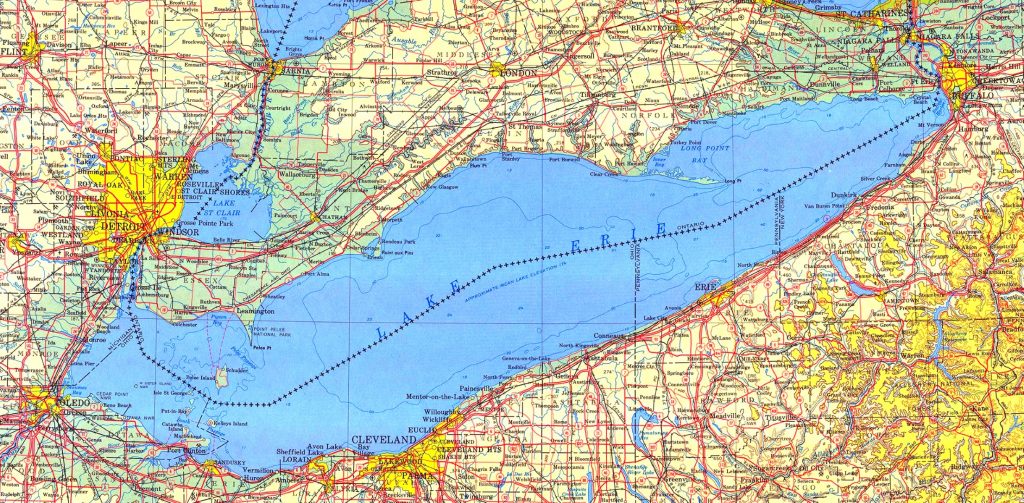Walleye have always been an important food source for Ohio natives. In early history they were found in the majority of Ohio rivers as well as Lake Erie. They’re easy to catch, simple to prepare and delicious. Today the population has soared to record levels. People from all over are flocking to the lake to enjoy Ohio’s favorite pastime. Here we look back on the histories of Lake Erie, Walleye and fishing.

Lake Erie
Lake Erie is the fourth largest lake by surface area of the five Great Lakes. It is the southernmost and shallowest of the Great Lakes and is situated on the International Boundary between Canada and the United States. North of Lake Erie is the Canadian province of Ontario. The Eastern, Western and Southern shores are the US States of Michigan, Ohio, Pennsylvania and New York.
The Lake was named by the Erie people who lived along the southern shore. The tribal name “Erie” is shortened form of the Iroquoian word erielhonan, meaning “long tail”.
The Erie people lived in what is now western New York, northwestern Pennsylvania and northern Ohio before 1658. They were destroyed in the mid-17th century by five years of prolonged warfare with the powerful neighboring Iroquois for helping the Huron in the Beaver Wars for control of the fur trade.
What’s a Walleye?
Walleye (Stizostedion vitreum vitreum) can be identified by their brassy, olive-colored back and sides and white stomach. They have no distinguishing features except for sharp teeth, whitish eyes, a dark spot on the webbing between the last three spines of the first dorsal fin, and a white tip on the lower portion of the caudal fin. Walleye belong to the perch family. They are known by many names including the pike-perch, walleyed pike, and jack salmon.
The name walleye, comes from the fact that the fish’s eyes point outward, as if looking at the walls. This orientation of the eyes gives anglers an advantage in the dark because a certain eye shine is given off by the eye of the walleye in the dark, similar to that of other nocturnal animals. This “eye shine” is the result of a light-gathering layer in the eyes which allows the fish to see well in low-light conditions. In fact, many anglers look for walleyes at night since this is when major feeding efforts occur. The fish’s eyes also allow them to see well in turbid waters, which gives them an advantage over their prey. Walleye anglers commonly look for locations where a good “walleye chop” or rough waters occur.

Original Methods
Early methods used by the settlers were generally the same ones the Native Americans used. The techniques were extremely crude by today’s standards. They used weirs and drag nets made of brush in bays and streams. There were very few options for packing, transporting and preserving the fish at that time. Not many fish were actually used or sold. They would catch just enough to supply the local markets and then set the rest free.
The rapid growth of the Midwest after the War of 1812 was also reflected in the fishery, which by 1830 had attained some importance in the economy of the area. Twine nets and seines, first put to commercial use about 1815, soon began to replace the primitive brush gear, but until about 1850, commercial fishing was only in the shallow areas near shore, and in bays, marshes, and rivers. Deep-water fishing was seldom undertaken and was limited to the use of trot lines and hook and line.
In the mid-1800’s many mills were built along the rivers and streams to use the water power. Pools below the dams concentrated the fish migrating upstream, and mill owners often leased seining rights in the pools to commercial fishermen. Some dam owners are also reported to have built cribs on the aprons of their dams, and by directing the water flow into the cribs, caught many downstream-migrating fish.

Population Recovery
In the 1950’s the walleye population dropped because of over fishing and the pollution in the lake harming spawning sites. The earlier construction of dams in many of the waterways walleye used for spawning was also considered a factor in the decline. The Cuyahoga River caught fire in 1969 showing just how bad the health of Lake Erie was. Commercial fishing for walleye in Ohio was discontinued in 1970.
“The lake was a pea green soup and walleye fishing had collapsed. It was in the dump and things were so bad that some people thought it would never get better,” said Roger Knight, the retired Lake Erie Fisheries Program Administrator for the Ohio Department of Natural Resources, Division of Wildlife, who worked out of the Sandusky Fisheries Research Station.
Thanks to the clean water act of 1972 the pollution of the lake slowly but surely started to turn around. The mercury levels of Walleye returned to a much safer, lower level and set the stage for a huge Walleye resurgence in the 1980’s.
For sport fishing, the 1980’s were a great combination of an environmental recovery and large walleye hatches. This brought quite a bit of angler interest to Lake Erie. In 1988 anglers caught almost 4.9 million walleye, which at that time was the highest sport fishing harvest on record. With over 1,200 charter captains taking anglers out daily, these were considered the golden years.
The majority of the 90’s were mostly quiet in the walleye world. They brought average hatches pretty consistently every year. The next big hatch year was 2003. It was the largest recorded in the 30 years that fisheries experts have been monitoring hatches. Since then Walleye fishing has seemed to only get better every year. Today it’s not uncommon to get your boat’s limit in only a couple hours. Some estimates put the current total population of Walleye around 100 million. This has started talk of raising the daily bag limit currently set at six walleyes from May through February, and a limit of four during the spawning months of March and April.

Walleye Capital of the World
Without a doubt, walleye are one of the most prized game fish in Ohio. Lake Erie produces more fish than all the other Great Lakes combined. The lake is often called the “Walleye Capital of the World.” There are a huge number of charter boats that will take walleye fishermen out on the lake for a day or more fishing. During the 1980’s and 90’s, over three million walleyes were harvested each year throughout Ohio. July 1998, Lake Erie saw catch rates of .8 fish per hour, the highest recorded since the mid-1980’s. Ohio’s 2003 sport harvest of walleye totaled 2,771,697 pounds. So far 2019 seems to be on track for even higher.
Why are there so many Walleye today?
The voluminous walleye hatch apparently was the product of a perfect alignment between weather conditions and microorganisms. Researchers initially had low expectations after an early winter warm-up, but that was quickly followed by a sudden cold spell from mid-March into April, which appears to have influenced a protracted spawning period. The cold early spring likely aligned the production of zooplankton with the walleye hatch, providing an abundance of food for the tiny walleye to feed on.
The Ohio Department of Natural Resources reported that 1996, 2003 and 2018 had the most successful spawns of the the last 25 years. While some walleyes spawn on reefs and in tributaries across Lake Erie, their success is dictated by several factors, including weather, predators and food.
Millions of walleyes make their spawning run every spring. From mid-April to early May, walleye spawn at night. Males will wait for the females in the spawning areas that are generally in clear water, with a little current, and areas that are one to five feet deep with a gravel bottom. Unlike many fish, they do not build nests, but are free-spawners.
The number of eggs laid is dependent on the female’s body weight – 23,000-50,000 eggs per pound. Normally 100,000 – 400,000 eggs are produced. Spawning may take up to three weeks. Afterward, both adults return to deeper water, offering no protection for the eggs. After 12- 18 days, the fry will hatch. Of the total amount of eggs laid, only five to twenty per cent will actually hatch. Reasons for not hatching include cold-water temperatures, heavy winds blowing them onshore and silt covering the eggs.

ODNR Fishing Report
The Ohio Department of Natural Resources Lake Erie Fisheries Program manages sport and commercial fisheries for the 2.24 million acres of water under Ohio’s jurisdiction. Within this area, sampling activities are directed at three districts and provide information on how the fisheries and food web respond to changes in the ecosystem.
Anglers can expect excellent walleye fishing to continue thanks to strong hatches during the last 5 years. Recruitment was well above average in 2018, with trawl catches near or above record highs in some months, indicating strong recruitment to the fishery in coming years. Angler harvest increased from 1.3 million in 2017 to 2.0 million fish in 2018. This large increase in harvest can be attributed to fish from the strong 2015-year class reaching and exceeding the 15-inch minimum limit. The overall expectation for 2019 is for high catch rates with most of the catch coming from the 2014 and 2015 cohorts.
The Future
Walleye fishing on Lake Erie is in a great place but how long will it last? History has proven the cyclical nature of the hatches. The good years come and go in waves. There is some concern over the significant algal bloom that is expected to develop in western Lake Erie later this year, though it’s unlikely to impact the eastern part of the lake, which borders Pennsylvania. Only time will tell but right now it’s as good as it’s ever going to be. Lets enjoy the high catch rates and large sizes while we still can.

Excellent Article!
Such valuable information and so many historical facts I had never known until I read your blog post.
Looking forward to more!
Isn’t the heavy population of walleyes because they have cut the perch down to almost nonexistent.? Without prey they multiply.
I have been fishing L Erie from Angola to Buffalo harbor for about 60 years now, and I remember back in the 50’s we caught a lot of blue pike (mostly at night). I have heard different stories about why the species disappeared (over fishing, introduction of smelt, other ?). Anyone have any other ideas ?
I feel in the spawning months the limit should be dropped or do a slot like bay de noc has
Lot of good information, about lake background of commercial fishing.